Table of Contents |
The membrane’s lipid bilayer structure provides the first level of control. The phospholipids are tightly packed together, and the membrane has a hydrophobic interior. This structure causes the membrane to be selectively permeable. A membrane that has selective permeability allows only substances meeting certain criteria to pass through it unaided. In the case of the cell membrane, only relatively small, nonpolar materials can move through the lipid bilayer (remember, the lipid tails of the membrane are nonpolar). Some examples of these are other lipids, oxygen and carbon dioxide gasses, and alcohol. However, water-soluble materials—like glucose, amino acids, and electrolytes—need some assistance to cross the membrane because they are repelled by the hydrophobic tails of the phospholipid bilayer.
All substances that move through the membrane do so by one of two general methods, which are categorized based on whether or not energy is required. Passive membrane transport (or passive transport) is the movement of substances across the membrane without the expenditure of cellular energy. In contrast, active membrane transport (or active transport) is the movement of substances across the membrane using energy from adenosine triphosphate (ATP).
In order to understand how substances move passively across a cell membrane, it is necessary to understand why any material moves within a solution. A concentration gradient is the difference in concentration of a substance across a space. Molecules (or ions) will spread/diffuse from where they are more concentrated to where they are less concentrated until they are equally distributed in that space. When molecules move in this way, they are said to move down their concentration gradient. Diffusion is the movement of particles from an area of higher concentration to an area of lower concentration. This movement requires no energy because a concentration gradient provides natural force to move substances from high to low concentration areas.
EXAMPLE
Below are two real-world examples to help illustrate the concept of concentration gradient.Whenever a substance exists in greater concentration on one side of a semipermeable membrane, such as the cell membranes, any substance that can move down its concentration gradient across the membrane will do so. Consider substances that can easily diffuse through the lipid bilayer of the cell membrane, such as the gasses oxygen (O₂) and carbon dioxide (CO₂). O₂ generally diffuses into cells because it is more concentrated outside of them, and CO₂ typically diffuses out of cells because it is more concentrated inside of them. Both gasses travel through the phospholipid bilayer from the side with a higher concentration to a side with a lesser concentration without the use of proteins or energy to do so. Therefore, they use a form of passive transport called simple diffusion to move across the membrane.
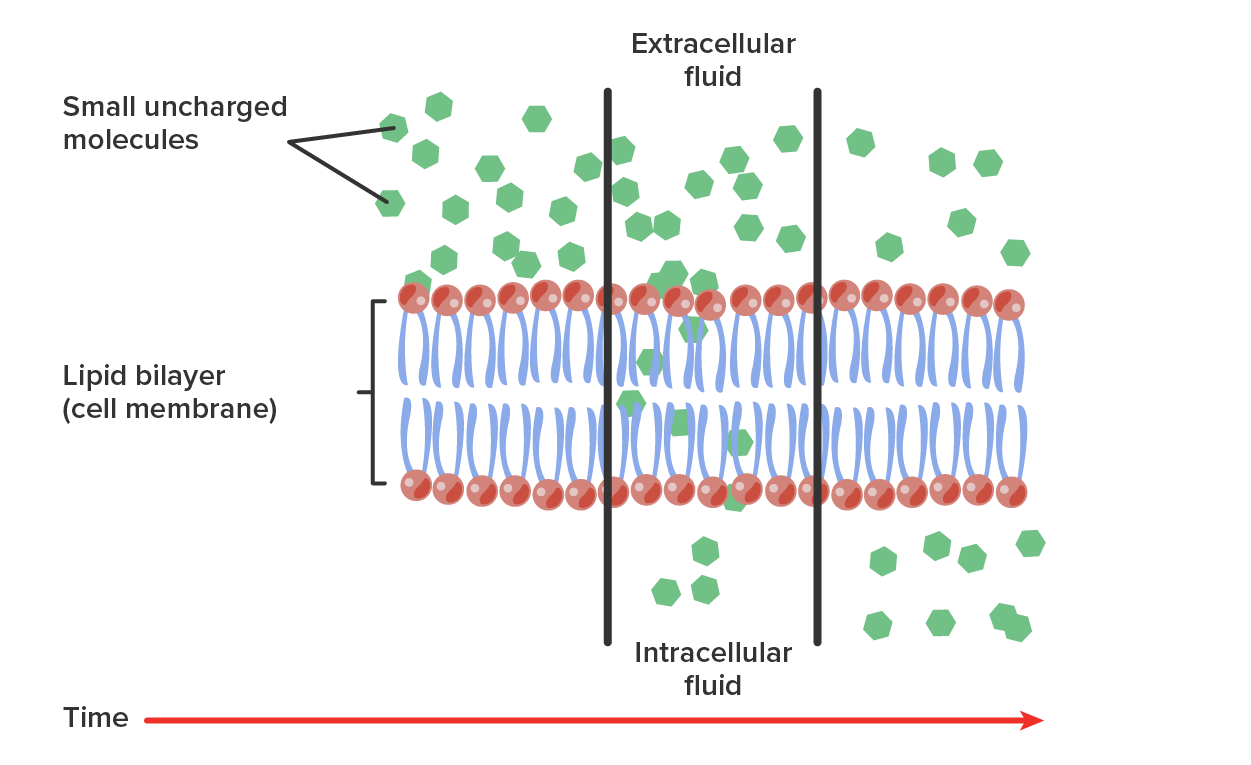
Very small polar molecules, such as water, can cross via simple diffusion due to their small size. Large polar or ionic molecules, which are hydrophilic, cannot easily cross the phospholipid bilayer. Charged atoms or molecules of any size cannot cross the cell membrane via simple diffusion as the charges are repelled by the hydrophobic tails in the interior of the phospholipid bilayer. Solutes dissolved in water on either side of the cell membrane will tend to diffuse down their concentration gradients, but because most substances cannot pass freely through the cell membrane, their movement is restricted to membrane proteins that facilitate their transport across the membrane. Facilitated diffusion is a form of passive membrane transport used for substances that cannot cross the lipid bilayer on their own due to their size, charge, and/or polarity and require a transmembrane protein to facilitate their movement down their concentration gradient. Channel proteins are transmembrane proteins that create a channel or pore that is typically open at all times, allowing certain molecules to pass through the membrane down their concentration gradient. Carrier proteins are transmembrane proteins that are only open on one side of the membrane at a time and must “carry” their specific molecules across the membrane. Once the molecule is bound to the carrier protein, it will change shape and allow the molecule to exit on the opposite side of the membrane as shown in the image below.
EXAMPLE
A common example of facilitated diffusion is the movement of glucose into the cell, where it is used to make ATP. Although glucose can be more concentrated outside of a cell, it cannot cross the lipid bilayer via simple diffusion because it is both large and polar. To resolve this, a specialized carrier protein called the glucose transporter will transfer glucose molecules into the cell to facilitate its inward diffusion.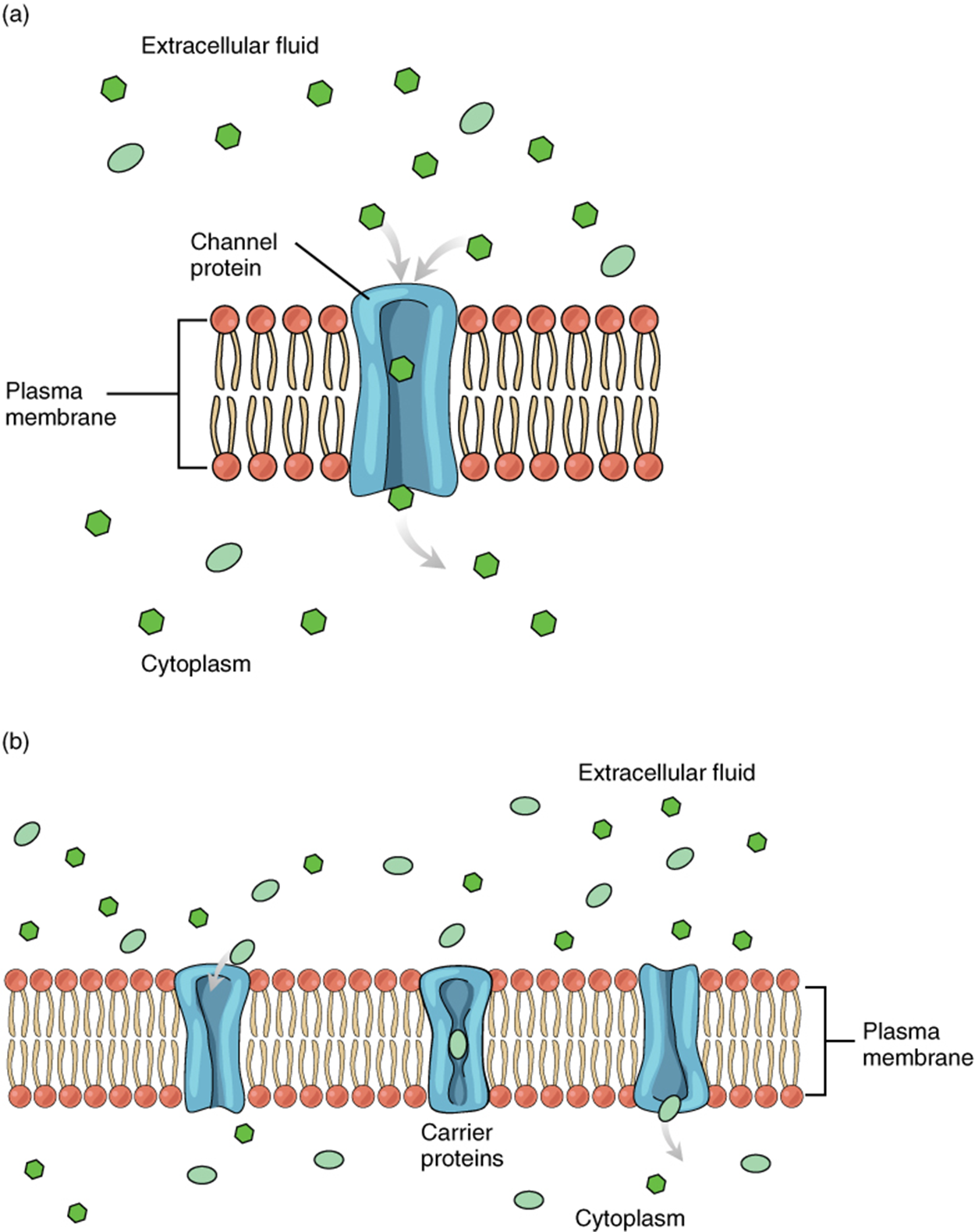
EXAMPLE
As another example, even though sodium ions (Na⁺) are highly concentrated outside of cells, these electrolytes are charged and cannot pass through the nonpolar lipid bilayer of the membrane. Their diffusion is facilitated by membrane proteins that form sodium channels (or “pores”) so that Na⁺ ions can move down their concentration gradient from outside the cells to inside the cells. There are many other solutes that must undergo facilitated diffusion to move into a cell, such as amino acids, or to move out of a cell, such as wastes. Because facilitated diffusion is a passive process, it does not require energy expenditure by the cell. It does, however, require channel or carrier proteins to be available and open. Recall that the cell membrane is selectively permeable. If the proper transport protein is not available or not open, then no matter how strong the concentration gradient is, that solute will be unable to pass through.Water also can move freely across the cell membrane of all cells, either through a specific protein channel for water called an aquaporin or by slipping between membrane phospholipids themselves. Osmosis is the diffusion of water through a semipermeable membrane down its concentration gradient.

The movement of water molecules is not itself regulated by some cells—water moves at any moment across the membrane based on its concentration gradient—so it is important that these cells are exposed to an environment in which the concentration of solutes outside of the cells (in the extracellular fluid) is equal to the concentration of solutes inside the cells (in the intracellular fluid). Two solutions that have the same concentration of solutes are said to be isotonic (equal tension). When cells and their extracellular environments are isotonic, the concentration of water molecules is the same outside and inside the cells and the cells maintain their normal shape (and function).
Osmosis occurs when there is an imbalance of solutes outside of a cell versus inside the cell. A solution that has a higher concentration of solutes than another solution is said to be hypertonic (hyper, greater), and water molecules tend to diffuse into a hypertonic solution. Cells in a hypertonic solution will shrivel as water leaves the cell via osmosis. In contrast, a solution that has a lower concentration of solutes than another solution is said to be hypotonic (hypo, lesser), and water molecules tend to diffuse out of a hypotonic solution. Cells in a hypotonic solution will take on too much water and swell with the risk of eventually bursting. A critical aspect of homeostasis in living things is to create an internal environment in which all of the body’s cells are in an isotonic solution. Various organ systems, particularly the kidneys, work to maintain this homeostasis.

For all of the transport methods described above, the cell expends no energy as all substances move down their concentration gradient. During active membrane transport, ATP is required to move a substance across a membrane, often with the help of protein carriers, and usually against a concentration gradient.
One of the most common types of active transport involves proteins that serve as solute pumps, using energy stored in ATP to move solutes across the membrane against their concentration gradient.

Active transport pumps can also work together with other active or passive transport systems to move substances across the membrane. For example, in neurons and muscle cells, the sodium-potassium pump works to maintain a high concentration of sodium ions outside and potassium inside the cell. Therefore, if the cell needs sodium ions in the intracellular space, all it has to do is open a passive sodium channel as the concentration gradient of the sodium ions will drive them to diffuse into the cell. In this way, the action of an active transport pump (the sodium-potassium pump) powers the passive transport of sodium ions by creating a concentration gradient. When active transport powers the transport of another substance in this way, it is called secondary active transport.
Symporters are secondary active transporters that move two substances in the same direction. For example, the sodium-glucose symporter shown in the image below uses sodium ions to “pull” glucose molecules into the cell. Because cells store glucose for energy, glucose is typically at a higher concentration inside of the cell than outside. However, due to the action of the sodium-potassium pump, sodium ions will easily diffuse into the cell when the symporter is opened. The flood of sodium ions through the symporter provides the energy that allows glucose to move through the symporter and into the cell against its concentration gradient.

Conversely, antiporters are secondary active transport systems that transport substances in opposite directions. For example, the sodium-hydrogen ion antiporter uses the energy from the inward flood of sodium ions to move hydrogen ions (H⁺) out of the cell (see image above). The sodium-hydrogen antiporter is used to maintain the pH of the cell's interior.
Other forms of active transport do not involve membrane protein carriers. Cytosis is a process of transporting substances into or out of the cell by packing them into enveloped portions of the cell membrane. These materials can either move into the cell by endocytosis (endo, inward) or out of the cell by exocytosis (exo, outward). Endocytosis (bringing “into the cell”) is the process of a cell ingesting material by enveloping it in a portion of its cell membrane and then pinching off that portion of membrane. Once pinched off, the portion of membrane and its contents becomes an independent, intracellular vesicle. A vesicle is a membranous sac—a spherical and hollow organelle bounded by a lipid bilayer membrane.

Endocytosis often brings materials into the cell that must be broken down or digested. Phagocytosis (“cell eating”) is the endocytosis of large particles. Many immune cells engage in phagocytosis of invading pathogens. Like little Pac-men, their job is to patrol body tissues for unwanted matter (such as invading bacterial cells) phagocytize them, and digest them. In contrast, pinocytosis (“cell drinking”) brings smaller amounts of fluid containing dissolved substances into a cell through membrane vesicles. Many cells perform pinocytosis in order to periodically survey their extracellular environment.
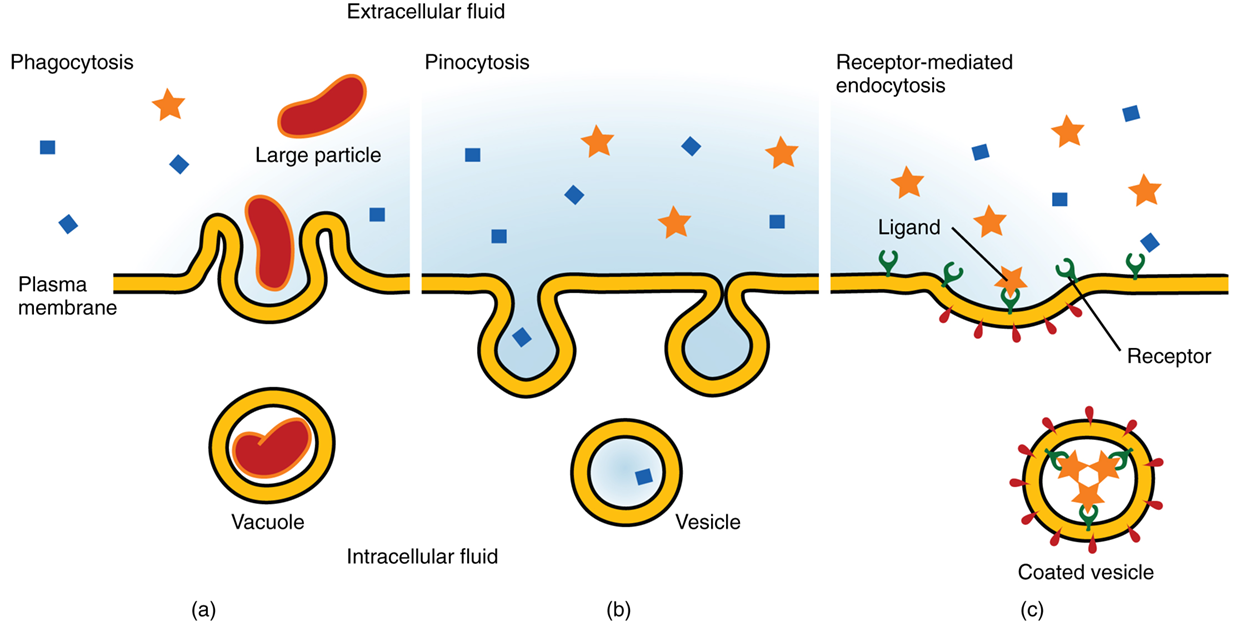
Phagocytosis and pinocytosis take in large portions of extracellular material, and they are typically not highly selective in the substances they bring in. Cells can regulate the endocytosis of specific substances via receptor-mediated endocytosis. Receptor-mediated endocytosis is the endocytosis of a specific ligand only once bound to a receptor specific to that ligand. Once the surface receptors have bound sufficient amounts of their specific ligand, the cell will endocytose the part of the cell membrane containing these complexes. Iron is a required component of hemoglobin, a key protein in the function of red blood cells (you will learn much more in the cardiovascular system). In order to obtain the iron they require, red blood cells will take it in from their surroundings by receptor-mediated endocytosis when it is available.
At times, materials also need to be expelled from a cell. 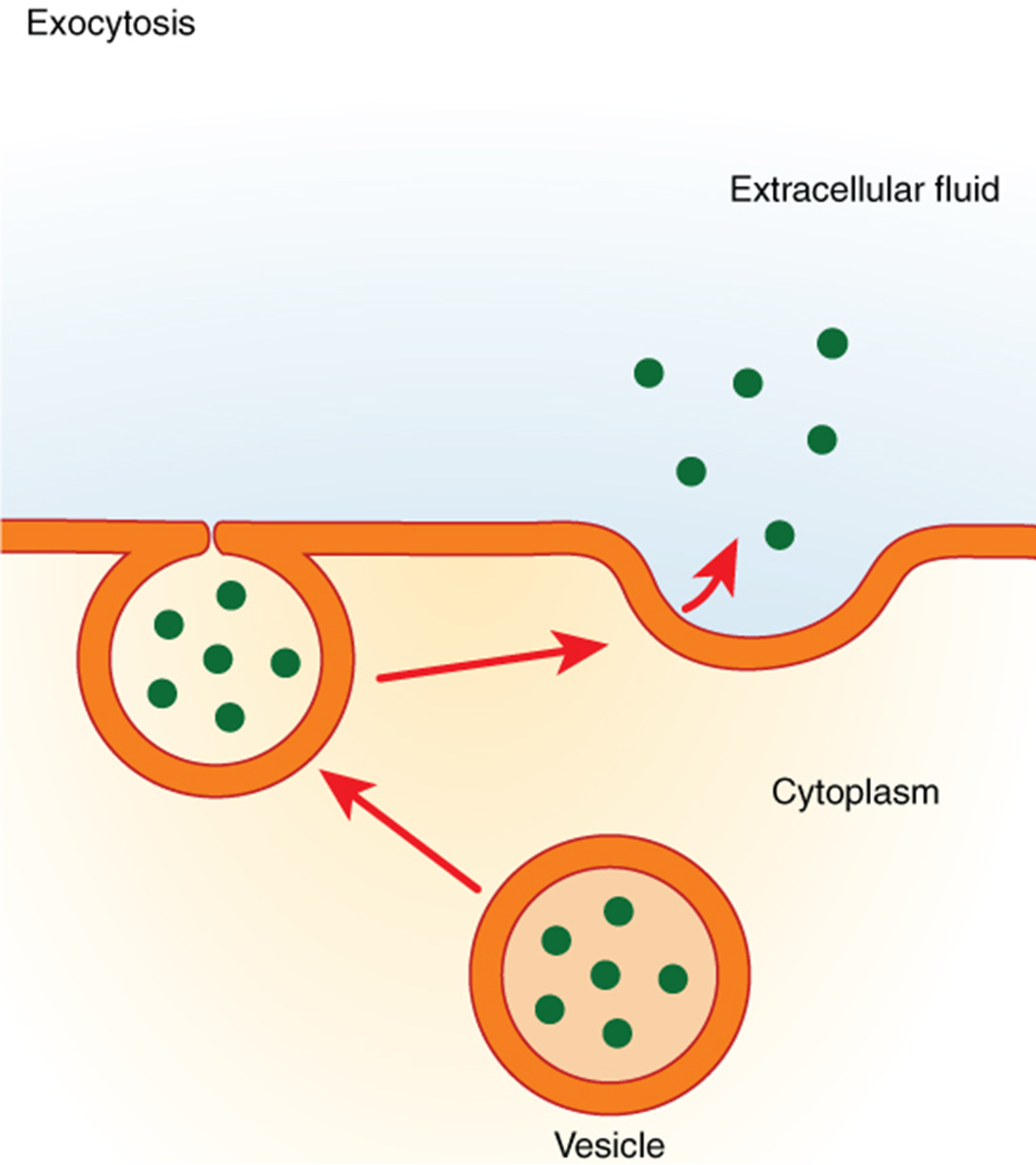 Exocytosis (taking “out of the cell”) is the process of a cell exporting material using vesicular transport. Many cells manufacture substances that must be secreted, like a factory manufacturing a product for export. These substances are typically packaged into vesicles within the cell. When the vesicle membrane touches and fuses with the cell membrane, the vesicle releases its contents into the surrounding extracellular space. The vesicle membrane then becomes part of the cell membrane. Cells of the stomach and pancreas produce and secrete digestive enzymes through exocytosis (see second image below). Endocrine cells produce and secrete hormones that are sent throughout the body, and certain immune cells produce and secrete large amounts of histamine—a chemical important for immune responses.
Exocytosis (taking “out of the cell”) is the process of a cell exporting material using vesicular transport. Many cells manufacture substances that must be secreted, like a factory manufacturing a product for export. These substances are typically packaged into vesicles within the cell. When the vesicle membrane touches and fuses with the cell membrane, the vesicle releases its contents into the surrounding extracellular space. The vesicle membrane then becomes part of the cell membrane. Cells of the stomach and pancreas produce and secrete digestive enzymes through exocytosis (see second image below). Endocrine cells produce and secrete hormones that are sent throughout the body, and certain immune cells produce and secrete large amounts of histamine—a chemical important for immune responses.
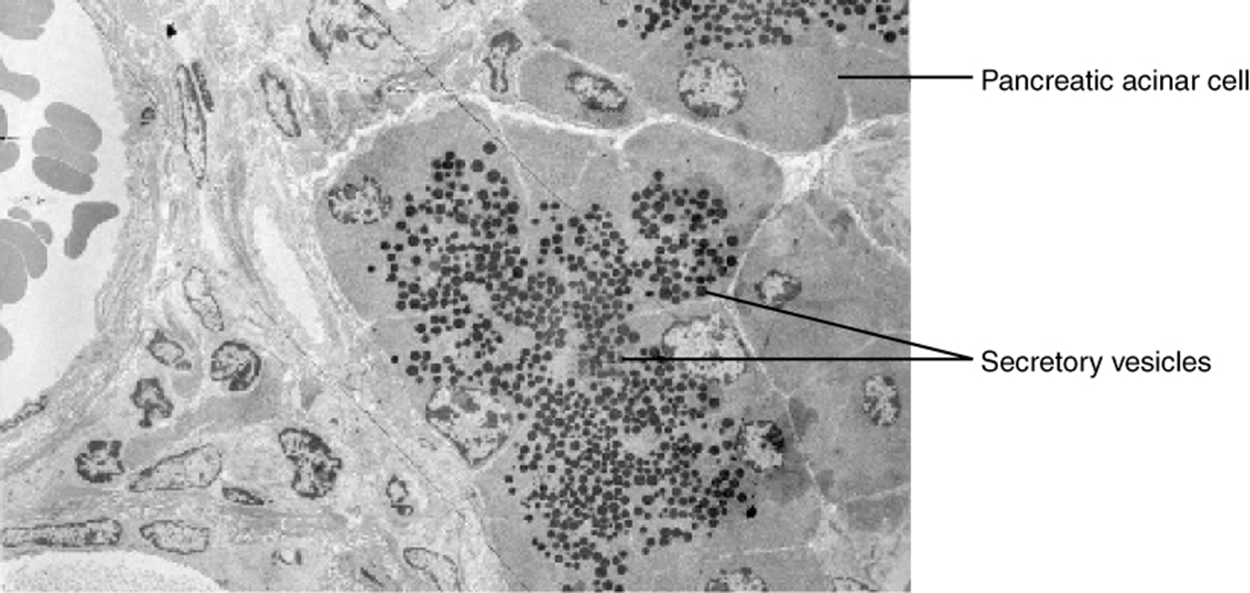
IN CONTEXT
Disease at the Cellular Level: Cystic Fibrosis
Cystic fibrosis (CF) is a genetic disease with a mutated genetic code for a chloride ion (Cl⁻) transporter, halting the transport of chloride across the membrane. This disease affects approximately 30,000 people in the United States, with about 1,000 new cases reported each year. It is most well known for its damage to the lungs, causing breathing difficulties and chronic lung infections, but it also affects the liver, pancreas, and intestines.
The symptoms of CF result from an ion channel called the cystic fibrosis transmembrane conductance regulator, or CFTR. In healthy people, the CFTR protein is an integral membrane protein that transports Cl⁻ ions out of the cell. In a person who has CF, the CFTR is mutated, thus, the cell manufactures a defective channel protein that is degraded by the cell.
The CFTR requires ATP in order to function, making its Cl⁻ transport a form of active transport. This characteristic puzzled researchers for a long time because the Cl⁻ ions are actually flowing down their concentration gradient when transported out of cells. Active transport generally pumps ions against their concentration gradient, but the CFTR presents an exception to this rule.
In normal lung tissue, the movement of Cl⁻ out of the cell maintains a C⁻ rich, negatively charged environment immediately outside of the cell. This is particularly important in the lining of the respiratory system. The lining of the respiratory system secretes mucus, which serves to trap dust, bacteria, and other debris. In order to be effectively moved upward, the mucus must have a thin, watery consistency. The accumulation of ions in the extracellular space creates solute-rich mucus, which has a low concentration of water molecules. As a result, through osmosis, water moves from cells and the extracellular matrix into the mucus, “thinning” it out. This is how, in a normal respiratory system, the mucus is kept sufficiently watered down to be propelled out of the respiratory system.
If the CFTR channel is absent, Cl⁻ ions are not transported out of the cell in adequate numbers, thus preventing them from drawing positive ions. The absence of ions in the secreted mucus results in the lack of a normal water concentration gradient. Thus, there is no osmotic pressure pulling water into the mucus. The resulting mucus is thick and sticky, and the respiratory system cannot effectively remove it. Passageways in the lungs become blocked with mucus, along with the debris it carries. Bacterial infections occur more easily because bacterial cells are not effectively carried away from the lungs.
Only about 50 years ago, the prognosis for children born with CF was very grim—a life expectancy rarely over 10 years. Today, with advances in understanding and medical treatment, many CF patients live into their 30s.
Source: THIS TUTORIAL HAS BEEN ADAPTED FROM OPENSTAX “ANATOMY AND PHYSIOLOGY 2E.” ACCESS FOR FREE AT HTTPS://OPENSTAX.ORG/DETAILS/BOOKS/ANATOMY-AND-PHYSIOLOGY-2E. LICENSE: CC ATTRIBUTION 4.0 INTERNATIONAL.